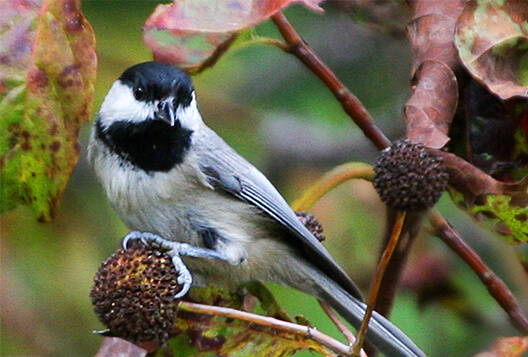What Birds Might You See in Your Yard in Autumn?—
Fall Migration through Southeastern North Carolina
Autumn is around the corner and is one of the busiest seasons for birds and wildlife. Even though winters are mild in Southeastern North Carolina, most birds that breed here during the spring and summer still fly farther south for our colder months. For birdwatchers, this fall migration season is one of the best times to find and photograph songbirds, birds of prey and waterfowl.
From September to early December, dozens of species of birds pass through area woodlands, parks, hedgerows and gardens—birds that breed here as well as species that breed farther north. Occasionally a rare or vagrant species might also turn up in our area. Migratory birds are attracted to areas close to water, such as Fort Fisher or Greenfield Lake. Many woodland birds travel different routes for their fall and spring migrations. Most northbound woodland birds travel along the Appalachian Mountains or the Mississippi River to reach their summer breeding grounds. On their southbound trip in the fall, many stay close to the coast and come closer to homes as they feed on fruits, seeds and insects. As a result, autumn migration is a much busier season for birds—and birdwatchers—in the Cape Fear area.
Autumn is a perfect time to learn about local bird species, whether you are a new birdwatcher or home gardener or just curious about nature. Birds that are normally in the canopy or dense undergrowth during the spring or summer might visit a flowerbed or hedge outside a home in the autumn months. Many birds also come to bird tables (or birdfeeders) and gather around fruit-bearing trees such as magnolias or dogwoods. Lastly, resident birds such as chickadees, titmice, woodpeckers, nuthatches, and Pine Warblers join mixed flocks with migrating or wintering species.
Among these “social gatherings” of resident species, observers may find visitors such as American Redstarts, Yellow-throated Vireos, or even Scarlet Tanagers. By late October, winter residents begin to show up with common “snowbirds” such as Myrtle Warblers (Yellow-rumped Warblers), White-throated Sparrows and goldfinches arriving around Halloween. Waterfowl arrive much later with most ducks, such as Mallards, Pintails, Mergansers, or Ruddy Ducks, showing up at lakes and ponds in early or mid-December. Observers can also look to the fall sky to see swallows, martins, and swifts forming massive flocks around lakes or urban areas, hawks or falcons darting along the seacoast, and kettles of Turkey Vultures sailing over the countryside.
New birdwatchers and casual gardeners with feeding stations can become acquainted with visiting and resident species just by observing the landscape around them. An ordinary suburban or urban garden could support 15–30 species of birds without any habitat improvements, artificial water or food sources. One could find Common Yellowthroats or seedeaters like Field Sparrows, Indigo Buntings, and goldfinches in a lush flowerbed or an open area with dense weeds. Any tree with fruits or berries will likely be used by Red-eyed Vireos, thrushes, catbirds, waxwings, or local flocks of bluebirds at some point. Southern Magnolia, sumac, elderberry, pokeweed and viburnums are among the strongest draws for fruit-eating birds.
Autumn is also a great time to think about attracting and hosting birds in the garden. Feeding stations become busier after the late summer, while milder temperatures make the outdoors more pleasant. Sit out in the garden or park for an hour on any morning or evening in September or October and watch the trees, plants and skies for movement. Even if a bird cannot be identified, take note of its behavior or what it is eating. This will give a general idea of what types of plants or trees to add. Most songbirds do not come to feeders but feed on natural foods found in the environment.
Some recommendations for attracting autumn migrants include planting fruit-bearing shrubs or trees such as Arrowwood Viburnum, American Beautyberry, dogwoods or, if there is enough space, Southern Magnolia and Hackberry. Native flowers such as coneflowers, Swamp Sunflower, Blazing Star and even the ubiquitous dandelion are major seed sources for sparrows, buntings, finches and cardinals. Water is always an important resource regardless of the season. A bird bath or small fountain can bring down colorful migrants that could otherwise be missed, while a water garden or small pond might lure oddities such as Wood Ducks, kingfishers, Green Herons, or Night Herons.
Birds are naturally drawn to edges (where one ecosystem transitions into another) and disturbed areas. Home gardens, neighborhoods, parks and roadsides are among the best places to find birds from autumn through early spring. Birdwatching in forests and swampland is more difficult, as the birds are often hidden in the trees or undergrowth. Clearings and trails are better spots within a natural area as they are attractive to a greater number of species than the interior.
In the Cape Fear Region, many trees and shrubs are evergreens, making visual identification of birds difficult in the winter as well. Autumn migrants are quiet with songbirds only giving soft call notes, or no sound at all. The Wilmington area has many wonderful places to view or photograph migrating birds. New Hanover County alone contains more than 50 parks and recreational areas; Greenfield Lake, Longleaf Park and Halyburton Park are especially good, accessible places to find birds year-round. Even small parks such as Maides Park, Wallace Park, Carolina Beach Lake and Wilmington’s Riverwalk are worth visiting.
Autumn is one of the best times to watch birds as they are easier to see, often venture close to our homes, and are attracted to seeds, fruits and other abundant foods. Anyone can take a few minutes to observe the birds and animals in their gardens or at a local park, woodland or meadow. September and October are the most active months for migration in the Cape Fear region, with trees and hedges filling up with birds whenever a major weather system blows through.
Some of the highlights to look for include the American Redstart, Common Yellowthroat, Veery Thrush, vireos, Sharp-shinned Hawk, Yellow-bellied Sapsucker, and the Common Flicker among dozens more. Lastly, do not forget to observe common garden species like nuthatches, chickadees, mockingbirds, or Carolina Wrens, as they also exhibit interesting behaviors such as food hoarding and establishing winter territories. Observing common garden species can also lead birdwatchers to spot a less common bird, such as an unusual species of warbler.
Thank you to Wild Bird & Garden for sponsoring this blog post. You can visit their shop at 3501 Oleander Drive, Wilmington, North Carolina for a selection of quality supplies and gifts for wild birds and the people who love them.



